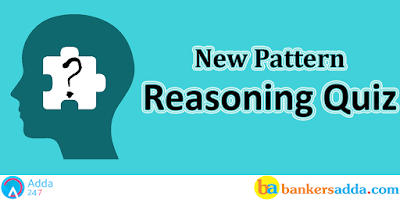Reasoning is a game of wits and presence of mind! Yes, it is true and it might seem as the greatest of the challenge after English Section’s surprises but yet this one can easily be dealt with. You just need correct practice and hardwire your brain to quickly make decisions of what to attempt and what to leave. And for same we are providing you questions on Night Class Reasoning Question. To Practice more with these new pattern Reasoning Question for RRB PO Exam 2017.
Directions (1-5): Read the following information and answer the questions that follow:
Twelve members of a family are sitting in two opposite sides of rectangular dining table for a dinner. Two parallel rows of chairs containing six people each are set in such a way that there is an equal distance between adjacent persons. In row 1, A, B, C, D, E and F are seated and all of them are facing south. In row 2, P, Q, R, S, T and O are seated and all of them are facing north, but not necessarily in the same order. Each of them likes different types of food, viz Indian, African, English, French,
German, Chinese, Italian, Mexican, Thai, Spanish, Korean and Russian, but not necessarily in the same order. C, who likes German food, sits third to the left of B. C is not an immediate neighbour of either E or A. P, who likes Korean food, sits third to the right of S. Neither P nor S sits at the extreme ends. E, who likes Indian food, faces the one who likes Mexican food. F, who likes English food, faces O, who sits second to the left of T and does not like French food. T is not an immediate neighbour of S. Only two people sit between Q and T, who like Russian and Thai food respectively. D likes neither African nor French food and sits on the immediate left of the person who likes German food. A, who likes Chinese food, does not face R. The one who likes Spanish food sits second to the right of the person who faces the one who likes African food. O does not like Spanish food. B and S does not like African food.
German, Chinese, Italian, Mexican, Thai, Spanish, Korean and Russian, but not necessarily in the same order. C, who likes German food, sits third to the left of B. C is not an immediate neighbour of either E or A. P, who likes Korean food, sits third to the right of S. Neither P nor S sits at the extreme ends. E, who likes Indian food, faces the one who likes Mexican food. F, who likes English food, faces O, who sits second to the left of T and does not like French food. T is not an immediate neighbour of S. Only two people sit between Q and T, who like Russian and Thai food respectively. D likes neither African nor French food and sits on the immediate left of the person who likes German food. A, who likes Chinese food, does not face R. The one who likes Spanish food sits second to the right of the person who faces the one who likes African food. O does not like Spanish food. B and S does not like African food.
Q1. Who faces the one, who likes African food?
(a) P
(b) S
(c) R
(d) F
(e) None of these
Q2. Which of the following food does S like?
(a) Italian
(b) French
(c) African
(d) Mexican
(e) None of these
Q3. Who sits diagonally opposite to T?
(a) D
(b) C
(c) F
(d) E
(e) None of these
Q4. Which of the following person likes Mexican Food?
(a) P
(b) S
(c) R
(d) T
(e) None of these
Q5. Who sits second to the right of the person, who faces the one, who likes African Food?
(a) B
(b) F
(c) A
(d) C
(e) None of these
Directions (6-10): In the questions given below, the relationship between different elements is shown in the statements. These statements are followed by two conclusions. Mark answer-
(a) If only conclusion I follows.
(b) If only conclusion II follows.
(c) If either conclusion I or II follows.
(d) If neither conclusion I nor II follows.
(e) If both conclusion I and II follow.
Q6. Statements: D=E≤F;G≥H>E
Conclusions: I. F < H II. G > D
Q7. Statements: M≤N<O;P>N>Q
Conclusions: I. Q < O II. P > M
Q8. Statement: J<K≤Q=L>M
Conclusions: I. J < L II. K > M
Q9. Statements: P=Q<L≤M;Q>I;L>H
Conclusions: I. P > H II. M > I
Q10. Statements: A≥B≥C>D>E;C≥F=G;D>M≥N
Conclusions: I. A > N II. B≥G
Directions (11-15): In each of the questions below are given four statements followed by four conclusions numbered I, II, III & IV. You have to take the given statements to be true even if they seem to be at variance with commonly known facts. Read all the conclusions and then decide which of the given conclusions logically follows from the given statements disregarding commonly known facts.
Q11. Statements:
Some trains are cars.
All cars are branches.
All branches are nets.
Some nets are dresses.
Conclusions:
I. Some dresses are cars.
II. Some nets are trains.
III. Some branches are trains.
IV. Some dresses are trains.
(a) Only I and III follow
(b) Only II and III follow
(c) Only I and IV follow
(d) Only II, III and IV follow
(e) None of these
Q12. Statements:
Some pencils are kites.
Some kites are desks.
All desks are jungles.
All jungles are mountains.
Conclusions:
I. Some mountains are pencils.
II. Some jungles are pencils.
III. Some mountains are desks.
IV. Some jungles are kites.
(a) Only I and III follow
(b) Only I, II and III follow
(c) Only III and IV follow
(d) Only II, III and IV follow
(e) None of these
Q13. Statements:
All papers are clips.
Some clips are boards.
Some boards are lanes.
All lanes are roads.
Conclusions:
I. Some roads are boards.
II. Some lanes are clips.
III. Some boards are papers.
IV. Some roads are clips.
(a) Only I and II follow
(b) Only I and III follow
(c) Only I, II and III follow
(d) Only II, III and IV follow
(e) None of these
Q14. Statements:
All pens are clocks.
Some clocks are tyres.
Some tyres are wheels.
Some wheels are buses.
Conclusions:
I. Some buses are tyres.
II. Some wheels are clocks.
III. Some wheels are pens.
IV. Some buses are clocks.
(a) None follows
(b) Only I follows
(c) Only II follows
(d) Only III follows
(e) Only IV follows
Q15. Statements:
All stones are hammers.
No hammer is a ring.
Some rings are doors.
All doors are windows.
Conclusions:
I. Some windows are stones.
II. Some windows are rings.
III. No window is a stone.
IV. Some rings are stones.
(a) Only I follows
(b) Only II follows
(c) Only III follows
(d) Only either I or III follows
(e) Only either I or III and II follow







